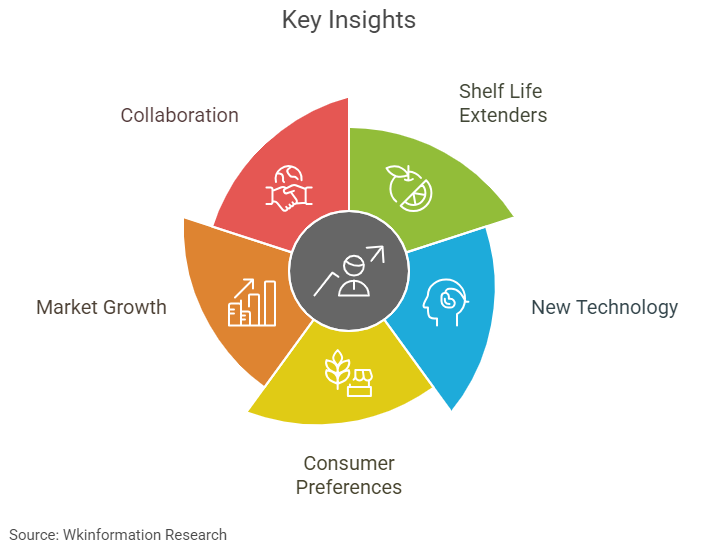
The Shelf Life Extenders market is experiencing significant growth, with its size projected to reach USD 5.71 billion by 2025 and further expand to USD 12.42 billion by 2033. This represents a robust compound annual growth rate (CAGR) of 10.2% from 2025 to 2033. The growth is driven by the increasing demand from the food and beverage industry for solutions that can extend product shelf life, reduce waste, and enhance product quality. Advances in preservation technologies, along with rising consumer preference for longer-lasting, fresher products, are also contributing to the market’s expansion.
Key Insights
- Shelf life extenders cut food waste by half, saving resources.
- New tech, like smart packaging, boosts shelf life extender sales.
- People want fresh, less processed food, pushing new ideas.
- Growing cities and incomes in new markets drive industry growth.
- Teamwork between tech firms and food makers creates better solutions.

Market Overview
Key Drivers of Growth
Several factors are propelling the growth of the shelf life extenders market. Innovations in artificial intelligence (AI), automation, and the Internet of Things (IoT) have revolutionized the industry. These technologies optimize operational efficiency and improve product offerings, enabling businesses to meet evolving consumer demands while reducing costs. Sustainability has emerged as a critical driver, with industries and consumers prioritizing eco-friendly solutions. Companies are investing in green technologies to align with these preferences and capture a larger market share. Additionally, the rapid adoption of digital transformation strategies and investments in emerging markets are fueling market growth.
Role of Shelf Life Extenders in the Food Industry
Shelf life extenders play a pivotal role in the food industry by addressing critical challenges related to waste reduction and product quality. Research shows that extending the shelf life of food products can prevent up to 50% of consumer food waste. This not only conserves resources but also enhances food safety and quality. For example, shelf life extenders help maintain the taste, texture, and nutritional value of food items, ensuring they remain fresh for longer periods.
By minimizing spoilage, these solutions align with the industry’s goals of sustainability and efficiency. They also support informed decision-making among food producers and retailers, enabling them to address consumer demands effectively.
Key Trends in the Shelf Life Extenders Market

Technological Advancements
Innovations in natural preservatives
The shelf life extenders market has witnessed a shift toward natural preservatives, driven by advancements in biotechnology. Probiotic cultures and enzymes now play a crucial role in food preservation, offering solutions that maintain nutritional value without compromising safety. These innovations align with consumer preferences for clean-label products, which emphasize recognizable and natural ingredients. Companies leveraging these advancements are better positioned to meet the growing demand for healthier and sustainable options.
Smart packaging solutions
Smart packaging technologies have revolutionized the shelf life extenders market. Active and intelligent packaging solutions now respond to environmental changes, ensuring optimal food preservation. For instance, sensors embedded in packaging can monitor temperature and humidity, alerting consumers to potential spoilage. These technologies not only enhance operational efficiency but also reduce waste, aligning with the trend report’s emphasis on sustainability. Businesses adopting these solutions gain a competitive edge by addressing both consumer demands and environmental concerns.
Sustainability and Eco-Friendly Solutions
Demand for biodegradable and non-toxic products
The demand for eco-friendly and biodegradable shelf life extenders continues to rise. Consumers increasingly prioritize products that minimize environmental impact, prompting companies to invest in green technologies. Packaging solutions that extend shelf life while reducing waste have gained significant traction. These emerging trends reflect a broader shift toward sustainability, with industries focusing on reducing their ecological footprint.
Regulatory support for sustainable practices
Regulatory frameworks now encourage the adoption of sustainable practices in the shelf life extenders market. Governments worldwide are implementing policies that promote the use of non-toxic and biodegradable materials. Companies aligning with these regulations benefit from enhanced market access and consumer trust. This regulatory push further accelerates the growth of eco-friendly solutions, positioning sustainability as a key driver in the industry.
Changing Consumer Preferences
Rising demand for fresh and minimally processed foods
Consumers increasingly seek fresh and minimally processed foods, driving demand for advanced shelf life solutions. Millennials and Generation Z, in particular, prefer organic and natural products that emphasize health and sustainability. This shift has encouraged manufacturers to develop innovative solutions that preserve freshness without relying on artificial additives. The trend report highlights this as a critical factor shaping the market.
Increased awareness of food waste reduction
Awareness of food waste reduction has grown significantly among consumers. Many now recognize the environmental and economic benefits of minimizing waste, prompting a surge in demand for shelf life extenders. Products that align with these values, such as natural preservatives and smart packaging, resonate strongly with environmentally conscious buyers. This trend underscores the importance of innovation in addressing both consumer needs and global challenges.
Regional Analysis of the Shelf Life Extenders Market

North America
Market size and key drivers
The shelf life extenders market in North America is poised for substantial growth. Technological advancements and a well-established infrastructure have positioned this region as a leader in adopting innovative solutions. The United States and Canada are at the forefront, driven by industrial applications and consumer demand for advanced preservation methods. Key factors contributing to this growth include:
- Increasing demand for processed foods.
- Rising awareness of food safety and quality.
- Technological advancements in food preservation.
- Growing consumer preference for natural and organic ingredients.
- Expansion of ecommerce platforms.
These trends highlight North America’s focus on innovation and its ability to meet evolving consumer expectations.
Major players and innovations
Major players in North America are leveraging cutting-edge technologies to enhance shelf life solutions. Companies are investing in smart packaging and natural preservatives to cater to the growing demand for sustainable and effective products. These innovations align with the region’s emphasis on reducing food waste and improving food safety standards.
Europe
Focus on sustainability and regulatory frameworks
Europe has emerged as a key player in the shelf life extenders market, with a strong emphasis on sustainability. Regulatory frameworks across the region encourage the adoption of eco-friendly practices, driving the development of biodegradable and non-toxic solutions. Governments actively support initiatives that reduce environmental impact, creating opportunities for companies to align with these policies and gain consumer trust.
Growth in natural and organic shelf life extenders
The trend report highlights Europe’s focus on natural and organic solutions. Innovations in active and intelligent packaging ensure optimal freshness by responding to environmental changes. Biotechnology advancements, such as probiotic cultures and enzymes, offer enhanced preservation while maintaining nutritional value. These trends reflect the region’s commitment to clean-label products and sustainable practices.
Asia-Pacific
Rapid urbanization and growing food industry
Asia-Pacific represents a rapidly expanding market for shelf life extenders. Urbanization and a growing food industry have increased the demand for effective preservation solutions. Countries like China and India are witnessing significant growth due to rising disposable incomes and changing dietary habits. This region’s dynamic food sector creates opportunities for companies to introduce advanced technologies.
Increasing adoption of advanced preservation technologies
The adoption of advanced preservation technologies is accelerating in Asia-Pacific. Smart packaging and natural preservatives are gaining traction as consumers prioritize food safety and quality. Companies investing in these innovations are well-positioned to capitalize on the region’s growing demand for sustainable and efficient solutions.
Rest of the World
Emerging markets and untapped potential
Emerging markets in Latin America and the Middle East & Africa present significant opportunities for the shelf life extenders industry. Economic development in these regions has fueled consumer demand for fresh and minimally processed foods. Latin America, in particular, has shown remarkable growth potential due to increasing investments in technology and infrastructure. Countries such as Brazil and Mexico are leading this transformation, with their expanding food industries driving the adoption of advanced preservation solutions.
The Middle East & Africa region is also experiencing a surge in demand for shelf life extenders. Economic diversification efforts, especially in Gulf countries, have created a favorable environment for market expansion. Investments in technology and food supply chain improvements have further enhanced the region’s potential. These developments highlight the untapped opportunities in these regions, where businesses can capitalize on growing consumer awareness and the need for sustainable food preservation methods.
Challenges in infrastructure and adoption
Despite the promising growth in emerging markets, several challenges hinder the widespread adoption of shelf life extenders. Infrastructural limitations remain a significant barrier, particularly in rural areas of Latin America and Africa. Inadequate cold storage facilities and inefficient transportation networks often lead to food spoilage before products reach consumers. These issues underscore the need for targeted investments in supply chain infrastructure to support the effective use of shelf life extenders.
Adoption challenges also stem from limited awareness among local food producers and distributors. Many small-scale businesses lack the resources or knowledge to implement advanced preservation technologies. Additionally, the high cost of some shelf life extension solutions can deter adoption in price-sensitive markets. Addressing these challenges requires collaborative efforts between governments, technology providers, and industry stakeholders to create affordable and accessible solutions.
Industry Segmentation in the Shelf Life Extenders Market
By Product Type
Antimicrobials
Antimicrobials are essential in preventing microbial growth, ensuring food safety, and extending shelf life. These agents are widely used in perishable products like meat, poultry, and seafood. Their ability to inhibit bacteria and fungi makes them a cornerstone in food preservation strategies.
Antioxidants
Antioxidants play a critical role in preventing oxidation, which leads to spoilage and rancidity. They are particularly effective in preserving the quality of oils, fats, and processed foods.
Enzymes
Enzymes are increasingly used to enhance food texture, flavor, and stability. They offer a natural alternative to chemical preservatives, aligning with consumer preferences for clean-label products. Their application spans dairy, bakery, and beverage industries.
Natural shelf-life extension additives
Natural additives, such as plant extracts and essential oils, have gained popularity due to their eco-friendly and non-toxic properties. These solutions cater to the growing demand for sustainable and organic food preservation methods.
By Application
Bakery and confectionery
Natural shelf life extenders maintain freshness and prevent spoilage in bakery and confectionery products. Consumer demand for clean-label items drives innovation in this sector.
Dairy and frozen products
Preservative agents combat microbial contamination in dairy and frozen products. Organic options are increasingly preferred, reflecting a shift toward healthier choices.
Meat, poultry, and seafood
Natural antioxidants and antimicrobials are vital for preserving the freshness and safety of meat, poultry, and seafood. Health concerns over synthetic preservatives influence this trend.
Fruits and vegetables
Shelf life extenders help retain the freshness of fruits and vegetables, reducing waste and ensuring quality during transportation and storage.
By End-User Industry
Food and beverage manufacturers
The food and beverage industry represents the largest consumer of shelf life extenders. Manufacturers rely on these solutions to meet regulatory standards, extend product longevity, and cater to consumer preferences for fresh and natural products.
Retail and distribution
Retailers and distributors use shelf life extenders to minimize spoilage and maintain product quality. These solutions are crucial for reducing losses in supply chains.
Hospitality and food service
The hospitality sector benefits from shelf life extenders by ensuring food safety and quality. These solutions support efficient inventory management and reduce waste in restaurants and catering services.
Challenges and Opportunities in the Shelf Life Extenders Market
Challenges
Regulatory hurdles and compliance issues
The shelf life extenders market faces significant regulatory challenges. Stringent standards complicate the approval process for new preservatives, increasing the cost and complexity of market entry. Consumer resistance to synthetic additives further limits innovation.
High costs of advanced technologies
The adoption of advanced preservation technologies incurs substantial initial costs. Research, development, and implementation require significant investment. While these technologies offer benefits like reduced waste and extended shelf life, manufacturers must balance innovation with economic feasibility. Cost-effective strategies are essential to ensure broader adoption across industries.
Consumer skepticism about chemical preservatives
Consumers increasingly prefer natural and organic solutions over chemical preservatives. Growing awareness of potential health risks associated with synthetic additives has created skepticism. This trend challenges manufacturers to innovate and develop alternatives that align with consumer expectations for safety and sustainability.
Opportunities
Growth in emerging markets
Emerging markets present immense growth potential for the shelf life extenders industry. Rising disposable incomes and urbanization have increased demand for packaged goods and convenience foods. Countries in Asia-Pacific and Latin America are adopting advanced solutions to meet these needs. Digital transformation across sectors further drives market expansion. Key opportunities include:
- Increased consumer demand for innovative shelf life extenders.
- Economic growth boosting purchasing power in emerging economies.
- Adoption of advanced technologies in food preservation.
Development of cost-effective and natural solutions
The demand for natural shelf life extenders continues to grow. Innovations like chitosan, derived from crustacean shells, offer antimicrobial and film-forming properties. Biotechnology advancements, including probiotic cultures and enzymes, provide effective preservation without compromising nutritional value. Companies are also exploring active and intelligent packaging solutions that respond to environmental changes, ensuring freshness. These developments align with consumer preferences for clean-label products and sustainable practices.
Collaboration between technology providers and food manufacturers
Collaborations between technology providers and food manufacturers create opportunities for innovation. Joint ventures and partnerships enable the development of integrated solutions that address both preservation and sustainability. By pooling resources and expertise, stakeholders can accelerate the adoption of advanced technologies and meet evolving consumer demands.
Competitive Landscape of the Shelf Life Extenders Market
Major Players in the Market
- Handary
- A&B Ingredients
- Mezzoni Foods
- ACE Ingredients
- Arjuna Natural
- TAKEX
- Hazel Technologies
- ITA
- Corbion
Profiles of leading companies
The shelf life extenders market features prominent players like Ingredion Incorporated and Corbion. Ingredion prioritizes innovation and customer satisfaction by offering a diverse range of solutions, including antioxidants and antimicrobial ingredients. Corbion, on the other hand, focuses on sustainability and environmental responsibility. The company produces lactic acid derivatives that serve as effective shelf life extenders. Both organizations actively invest in research and development to enhance their product offerings and maintain a competitive edge. Strategic partnerships further strengthen their market positions, enabling them to meet evolving consumer demands.
Key strategies and innovations
Leading companies in the market adopt strategies that emphasize technological advancements and sustainability. Ingredion leverages cutting-edge technologies to develop clean-label solutions, aligning with consumer preferences for natural products. Corbion integrates eco-friendly practices into its operations, ensuring its products meet stringent regulatory standards. These strategies not only drive innovation but also position these companies as leaders in the industry.
Emerging Players and Startups
Disruptive technologies and niche solutions
Emerging players and startups are introducing groundbreaking innovations that reshape the market.
- Advanced packaging solutions, such as active and intelligent packaging, respond to environmental changes to maintain product freshness.
- Natural preservatives, including plant-based additives, cater to the growing demand for clean-label products.
- Biotechnology advancements, such as probiotic cultures and enzymes, offer enhanced preservation while retaining nutritional value.
These innovations reflect the latest trends in the industry, as highlighted in the trend report, and address consumer demands for sustainable and effective solutions.
Regional players gaining traction
Regional players are gaining momentum by focusing on localized needs and preferences. Companies in Asia-Pacific and Latin America are leveraging their understanding of regional markets to introduce cost-effective and innovative solutions. Their ability to adapt to local trends positions them as strong competitors in the global market.
Strategic Partnerships and Collaborations
Joint ventures and R&D initiatives
Strategic partnerships play a pivotal role in shaping the shelf life extenders market. Companies collaborate with suppliers and distributors to expand their market reach and improve product offerings. Joint ventures often focus on research and development, enabling the creation of advanced preservation technologies. These initiatives drive innovation and ensure companies remain competitive in a rapidly evolving industry.
Mergers and acquisitions shaping the market
Mergers and acquisitions significantly influence the competitive landscape. Organizations enhance their technological capabilities and diversify their product portfolios through these collaborations. Access to emerging markets becomes more feasible, allowing companies to capitalize on untapped opportunities. These strategic moves not only strengthen market positions but also foster the development of innovative solutions that align with current trends.
Overview
The shelf life extenders market demonstrates robust growth, driven by technological advancements and increasing demand for sustainable solutions. Key trends include the adoption of eco-friendly practices and digital transformation strategies, which enhance operational efficiency and expand market reach. Regional dynamics reveal North America’s dominance due to strong infrastructure, Europe’s focus on innovation, and Asia-Pacific’s rapid industrialization and urbanization.
Stakeholders can capitalize on these predictions by prioritizing innovation and sustainability. Investing in R&D for natural ingredients, fostering transparency in production, and forming strategic partnerships with suppliers can unlock significant opportunities. These strategies align with evolving consumer preferences and position businesses for long-term success.
| Report Metric | Details |
|---|---|
| Report Name | Global Shelf Life Extenders Market Report |
| Base Year | 2024 |
| Segment by Type | · Antimicrobials
· Antioxidants · Enzymes · Natural Shelf-Life Extension Additives |
| Segment by Application | · Bakery and Confectionery
· Dairy and Frozen Products · Meat, Poultry, and Seafood · Fruits and Vegetables |
| Geographies Covered | · North America (United States, Canada)
· Europe (Germany, France, UK, Italy, Russia) · Asia-Pacific (China, Japan, South Korea, Taiwan) · Southeast Asia (India) · Latin America (Mexico, Brazil) |
| Forecast units | USD million in value |
| Report coverage | Revenue and volume forecast, company share, competitive landscape, growth factors and trends |
FAQ
What is the role of shelf life testing in the food industry?
Shelf life testing determines the duration a product remains safe and retains its quality under specific conditions. It helps manufacturers ensure compliance with safety standards, optimize storage, and meet consumer expectations for freshness.
How does accelerated shelf-life testing benefit manufacturers?
Accelerated shelf-life testing simulates aging processes to predict product longevity in a shorter time. This method allows manufacturers to quickly evaluate preservation techniques, reduce time-to-market, and improve product formulations.
What are the key factors influencing the effectiveness of shelf life extenders?
The effectiveness depends on product type, storage conditions, and the chosen preservation method. Factors like temperature, humidity, and packaging materials also play a significant role in maintaining product quality.
Are natural shelf life extenders as effective as synthetic ones?
Natural extenders, such as plant extracts and enzymes, offer comparable effectiveness to synthetic options. They align with consumer preferences for clean-label products while maintaining food safety and quality.
How do shelf life extenders contribute to sustainability?
Shelf life extenders reduce food waste by prolonging freshness and usability. This conservation of resources supports sustainability goals and minimizes environmental impact across the food supply chain.
Global Shelf Life Extenders Market Report – Table of Contents
1 Market Study Overview
2 Basic Product Information
3 Market Analysis
4 Shelf Life Extenders Related Market Analysis
5 Global Trend Summary
6 Competition by Manufacturer
7 Analysis of Key Players
8 Global Shelf Life Extenders Revenue, Sales Categorized by Regions
9 North America Shelf Life Extenders Market Size Categorized by Countries
10 Europe Shelf Life Extenders Market Size Categorized by Countries
11 Asia-pacific Shelf Life Extenders Market Size Categorized by Countries
12 South America Shelf Life Extenders Market Size Categorized by Countries
13 Middle East and Africa Shelf Life Extenders Market Size Categorized by Countries
14 Global Shelf Life Extenders Industry Segment Analysis
15 Global Shelf Life Extenders Market Forecast
16 Research Findings and Conclusion
17 Appendix


